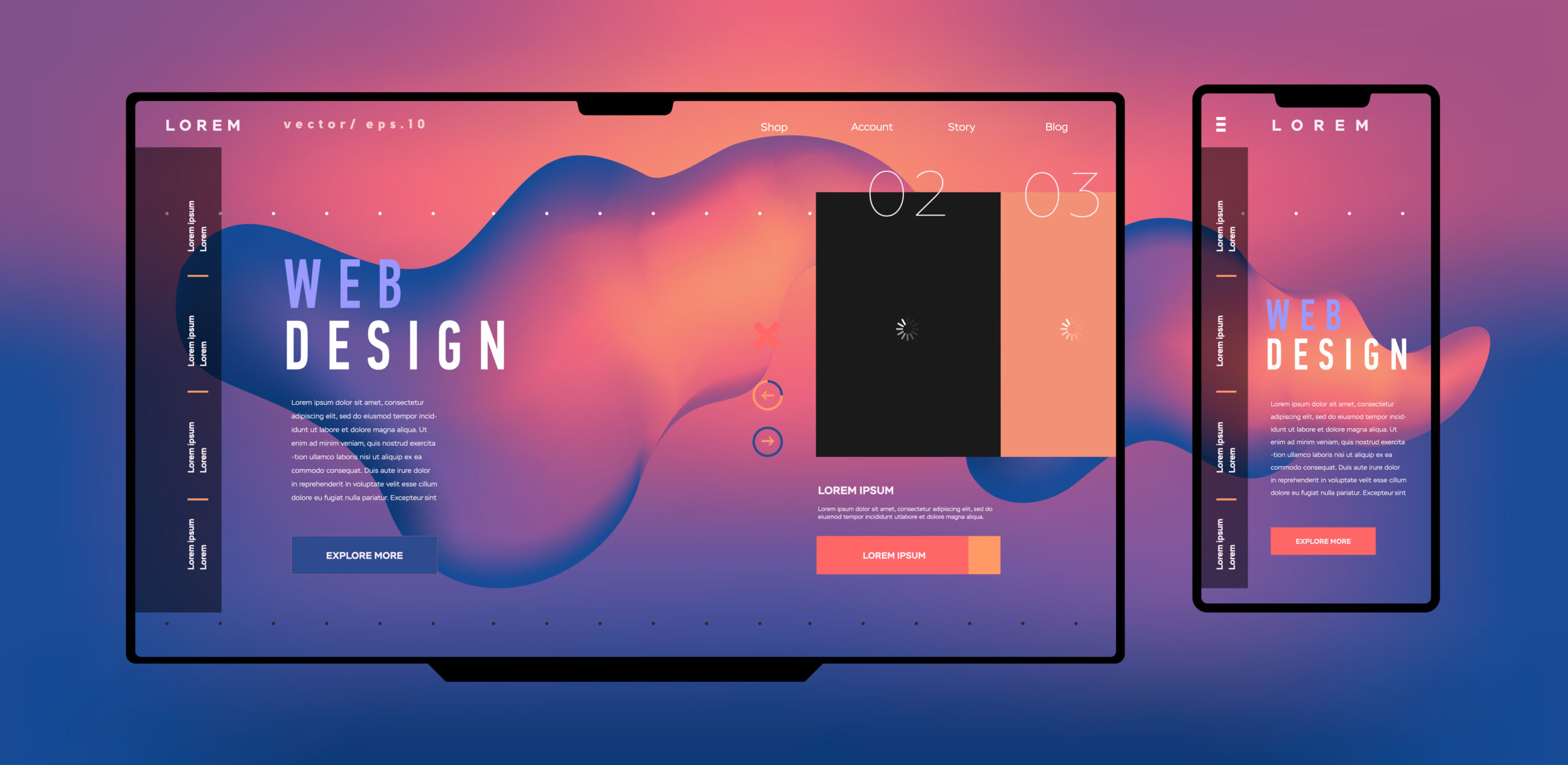The importance of responsive layouts explained by a top web design company
The Relevance of User Experience in Reliable Web Design Approaches
User experience (UX) functions as a cornerstone in efficient web design strategies. It forms how individuals interact with a website, influencing their contentment and probability of returning. A properly designed UX can improve involvement via user-friendly navigating and responsive designs. However, overlooking these facets may result in disappointment and raised bounce prices. Comprehending the ins and outs of UX is important for designers intending to create engaging digital experiences that reverberate with varied audiences. What variables genuinely drive successful user interaction?
Comprehending User Experience and Its Effect On Layout
User experience (UX) is frequently viewed as a plain element of web style, it fundamentally shapes just how individuals interact with an internet site. UX includes all aspects of the user's interaction, including usability, accessibility, and total satisfaction. A favorable UX fosters involvement, urging users to check out the website and return in the future. Conversely, a negative experience can lead to disappointment, causing high bounce prices and lost opportunities for conversion.
Design elements like navigating, layout, and material organization play essential duties fit this experience. Effective UX style expects user requirements and choices, guaranteeing that information is conveniently available and visually enticing. Furthermore, recognizing user habits via analytics can provide beneficial understandings, notifying style choices that improve usability. Ultimately, a comprehensive understanding of UX enables designers to create websites that not just attract users however likewise promote meaningful communications that line up with service objectives and user expectations.
Secret Principles of Reliable User Experience
Efficient user experience depends upon numerous vital concepts that improve site functionality and involvement. Intuitive navigating layout, receptive layout basics, and the significance of aesthetic pecking order are vital components that add to a seamless communication in between users and web material. Recognizing these principles allows developers to produce even more easily accessible and easy to use digital atmospheres.
Instinctive Navigation Style
Instinctive navigation design serves as a critical entrance to their total experience when users run into an internet site. Effective navigation enables users to easily locate the details they seek, boosting their interaction with the site. Trick concepts include clear labeling, logical organization, and constant positioning of navigating aspects. Labels should be uncomplicated, permitting users to predict the material they will certainly find. A well-structured power structure helps individuals comprehend the partnership between different sections, directing them via the website effortlessly. In addition, receptive food selections and easily available web links add to a liquid experience throughout tools. By focusing on intuitive navigating, developers can substantially reduce user frustration and rise involvement, ultimately cultivating a favorable perception of the internet site and its material.
Receptive Design Basics
A well-structured navigating system normally brings about the requirement for a receptive format, which is necessary in today's diverse electronic landscape. A responsive format guarantees that websites feature flawlessly throughout numerous gadgets, consisting of desktops, smartphones, and tablet computers. This versatility improves user experience by allowing web content to be aesthetically meaningful and easily obtainable, no matter screen dimension. Secret concepts of responsive style consist of fluid grids, versatile photos, and media inquiries, which help with suitable viewing. In addition, prioritizing touch-friendly elements enhances interaction on mobile phones. By carrying out a receptive layout, developers can fit customers' requirements, lessen bounce rates, and rise interaction. Eventually, a well-executed responsive style fosters a positive user experience, urging site visitors to explore the website better.
Visual Pecking Order Value
Visual power structure plays a vital duty in guiding individuals through a site, making sure that crucial details records their focus. By tactically utilizing size, contrast, shade, and spacing, developers can develop a clear pathway for customers to adhere to. Bigger elements often draw the eye, showing their relevance, while contrasting shades can highlight calls to action. Furthermore, constant alignment and collection of associated material improve comprehension, making navigation intuitive. Reliable use of aesthetic pecking order not just boosts usability yet also supports the general aesthetic of the website, promoting a favorable user experience. When individuals can quickly determine the most critical details, they are most likely to involve with the content, resulting in enhanced fulfillment and interaction with the internet site.
The Function of Use in Web Design
Usability plays a vital function in web design, specifically through navigating simpleness and adherence to ease of access standards. Effective navigation boosts user complete satisfaction by permitting visitors to discover details rapidly and without effort. Meanwhile, conference availability criteria assures that all customers, despite their abilities, can successfully communicate with the site.
Navigation Simpleness
Simplicity in navigation stands as a keystone of efficient web design, greatly influencing user experience. A streamlined navigation system enables customers to find info quickly and without effort, reducing aggravation and boosting fulfillment. Clear labeling and sensible structure are crucial elements, leading individuals easily through the web site. Redundant links or extremely intricate food selections can confuse customers, leading to boosted bounce rates. Additionally, mobile responsiveness should be thought about, making certain navigating stays simple across devices. Minimizing and focusing on necessary pages mess better sustains user interaction. Effective navigation not just promotes a favorable experience however likewise motivates individuals to check out the website straight from the source much more extensively, eventually resulting in higher conversion prices. In this respect, navigating simpleness works as a critical factor in the overall performance of web design methods.
Access Standards
User engagement is considerably boosted when web sites follow availability standards, making certain that all users, no matter their capacities, can navigate and connect properly. Conformity with these requirements not only broadens the audience but also boosts total user complete satisfaction. Accessible layout incorporates attributes such as text choices for images, key-board navigating, and adequate color comparison, which help with use by people with impairments. On top of that, implementing these criteria can positively influence search engine optimization (SEO) by enhancing website framework and clarity. As web design advances, prioritizing accessibility comes to be necessary in fostering an inclusive electronic environment. By welcoming these requirements, designers add to a much more fair net, eventually driving user loyalty and interaction.
Significance of Responsive Layout for User Engagement
As consumers increasingly gain access to web sites via a selection of tools, the significance of responsive design becomes vital for engaging individuals successfully. Receptive style warranties that an internet site adapts effortlessly to different display sizes, offering a suitable watching experience regardless of the device utilized. This adaptability improves user interaction by facilitating simpler navigation and communication with web content.
When customers experience a website that is responsive, they are more probable to remain much longer, check out additionally, and return in the future. A properly designed responsive design minimizes the frustration commonly associated with zooming and scrolling on smaller displays, consequently lowering bounce prices. Furthermore, receptive design can positively influence search engine rankings, as internet search engine focus on mobile-friendly sites. In today's digital landscape, where mobile use remains to increase, implementing responsive design is not simply advantageous, but vital for preserving user interaction and guaranteeing a positive experience throughout all tools.
Enhancing Load Times for Better User Contentment

To boost load times, web developers need to prioritize enhancing pictures, leveraging web browser caching, and decreasing HTTP demands. Additionally, employing Material Shipment Networks (CDNs) can speed up material shipment by dispersing it throughout numerous geographical locations. Improving code, such as pressing CSS and JavaScript documents, further contributes to quicker filling rates.
Ultimately, a commitment to improving tons times not just enhances user fulfillment however likewise reinforces brand commitment and enhances the probability of repeat check outs. A swift, seamless experience is necessary for preserving users and promoting favorable interactions.
The Impact of Visual Power Structure on User Interaction
Aesthetic power structure acts as an important component in assisting user interaction Homepage on a website. By organizing content in a way that focuses on info visually, developers can affect how users navigate and involve with a website. This pecking order is established via different style techniques, consisting of dimension, spacing, color, and comparison. Bigger font styles or strong shades attract attention to important aspects, such as calls to action or headings, while controlled colors and smaller sized font styles can indicate subservient details.
Reliable visual power structure assists customers swiftly identify what is most vital, lowering cognitive tons and improving use. It permits instinctive navigation, making it less complicated for individuals to discover what they require without disappointment. As individuals connect with a site, a well-structured aesthetic pecking order fosters a more enjoyable experience, ultimately bring about greater engagement and conversion prices. Developers must focus on these concepts to develop an user-centered and effective internet environment.
Gauging User Experience: Devices and Techniques

Frequently Asked Inquiries
How Can I Boost My Site's User Experience on a Spending plan?
To boost a site's user experience on a spending plan, one can optimize web page load speed, streamline navigation, apply receptive style, boost content clearness, and collect user comments for continual improvements, making certain a gratifying visitor experience.
What Are Typical User Experience Mistakes to Avoid in Web Design?
Common user experience blunders in web design consist of cluttered layouts, poor navigating, sluggish loading times, absence of mobile responsiveness, ignoring ease of access, irregular branding, and stopping working to focus on user comments - agency for web design. Each can substantially prevent overall site performance
How Usually Should I Update My Internet Site for Better User Experience?
Sites should be updated consistently, preferably every couple of months, to keep suitable user experience. Frequent updates assist address usability issues, refresh content, and adapt to transforming user requirements, making certain the website stays interesting and pertinent.

Can User Experience Influence Search Engine Optimization Rankings on My Website?
User experience can substantially influence SEO rankings, as search engines focus on web sites that supply seamless navigating, fast filling times, and appealing content. A favorable user experience can lead to reduced bounce rates and greater search visibility.
What Function Does Availability Play in User Experience Design?
Access plays an essential function in user experience design by making certain that all individuals, despite capacities, can interact and navigate with a web site effectively. This inclusivity improves total contentment and interaction amongst varied individuals.
User experience (UX) is frequently perceived as a plain element of web design, it essentially forms exactly how users communicate with a web site. User interaction is considerably boosted when sites stick to availability criteria, making sure that all customers, no matter of their capacities, can browse and interact effectively. Measuring user experience (UX) is crucial for understanding just how properly a website meets the demands of its customers. In addition, use screening, where actual users navigate the site while onlookers keep in mind troubles, uses straight feedback on user experience. Common user experience blunders in internet layout consist of messy layouts, poor navigating, slow-moving filling times, lack of mobile responsiveness, ignoring accessibility, irregular branding, and falling short to focus on user feedback.